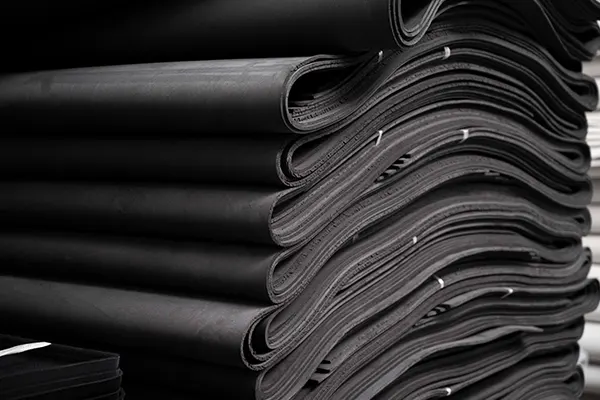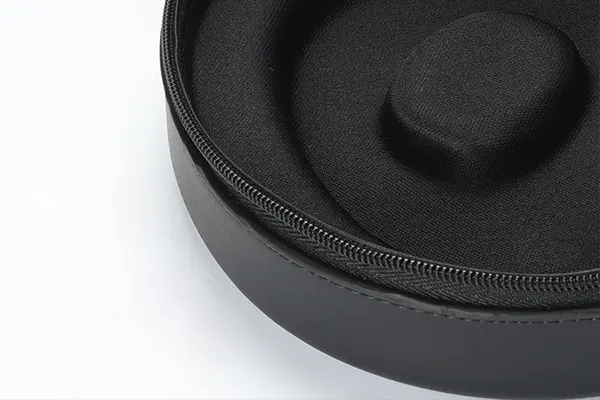En el reino de los materiales, EVA y PVC tienen una posición significativa debido a su naturaleza versátil y sus diversas aplicaciones. Mientras que ambos materiales tienen sus propias características y ventajas distintivas, Comprender las diferencias clave es crucial para tomar decisiones informadas en diversas industrias. En este artículo, profundizaremos en la composición, propiedades, y aplicaciones de EVA y PVC. Desentrañar los misterios detrás de estos materiales, Esperamos proporcionarle el conocimiento necesario para elegir el material adecuado para sus necesidades específicas..
¿Qué es el material de Eva??

EVA, un acrónimo de acetato de etileno-vinilo, es un copolímero realizado por la polimerización de los monómeros de etileno y acetato de vinilo. Esta composición es lo que le da a EVA sus propiedades únicas. El etileno proporciona una excelente tenacidad y flexibilidad, mientras que el acetato de vinilo mejora la adhesión y la estabilidad térmica. Además, La relación entre el contenido de etileno a acetato de vinilo determina la dureza y la suavidad del material EVA. Generalmente, Cuanto mayor sea el contenido de acetato de vinilo, lo más suave y más flexible se vuelve el EVA.
¿Qué es el material de PVC??

CLORURO DE POLIVINILO, o cloruro de polivinilo, es un polímero termoplástico sintético compuesto por unidades repetidas de cloruro de vinilo. La composición de PVC le otorga la capacidad de resistir una variedad de condiciones ambientales, convirtiéndolo en uno de los materiales más versátiles de la industria. Su excelente resistencia química, propiedades mecánicas, y la durabilidad ha convertido a PVC en un elemento básico en numerosos sectores.
EVA contra. CLORURO DE POLIVINILO: Proceso de fabricación
Materiales de Eva se fabrican a través de un proceso conocido como el Polimerización de alta presión de monómeros de etileno y acetato de vinilo. Este proceso implica el uso de un catalizador para iniciar la reacción, resultando en la formación de cadenas de copolímero de EVA. La composición del material final se determina controlando cuidadosamente la relación de etileno a acetato de vinilo durante el proceso de polimerización.
Por otro lado, PVC se produce a través de un proceso llamado polimerización por suspensión. En este método, Los monómeros de cloruro de vinilo se suspenden en agua, y se introduce un iniciador de radicales libres para iniciar la reacción de polimerización. La resina de PVC resultante se procesa aún más para lograr las características y propiedades deseadas. Vale la pena señalar que existen técnicas de producción alternativas como la polimerización de la emulsión y la polimerización a granel, cada uno con sus propias ventajas y características.
EVA contra. CLORURO DE POLIVINILO: Durabilidad


EVA exhibe una notable resistencia y resistencia al desgaste, haciéndolo una excelente opción para productos como caso de Eva que sufren uso frecuente y durabilidad de la demanda. La estructura de copolímero de EVA proporciona un equilibrio entre la fuerza y la flexibilidad, Permitir que resistir las fuerzas externas sin deformación o rotura. Su dureza inherente asegura que los materiales EVA mantengan su forma e integridad incluso en condiciones duras.
En comparación, PVC posee fuerza y resistencia excepcionales, permitiéndole resistir cargas pesadas y estrés físico. Las fuertes fuerzas intermoleculares de PVC proporcionan una excelente resistencia al impacto, haciéndolo adecuado para aplicaciones que requieren integridad estructural. Si se trata de tuberías, cables, o materiales para techos, La durabilidad de PVC lo convierte en una opción confiable para soluciones duraderas.
EVA contra. CLORURO DE POLIVINILO: Flexibilidad y elasticidad
La flexibilidad inherente de Eva es una de sus principales ventajas. Debido al alto contenido de acetato de vinilo, Eva exhibe una naturaleza suave y flexible, permitiendo que cumplir con varias formas y contornos. Esta versatilidad hace que Eva sea un material ideal para productos que requieren flexibilidad y facilidad de uso., como calzado, equipo deportivo, y materiales de embalaje.
En cambio, La elasticidad de PVC le permite recuperar su forma original después de la deformación. Esta característica hace que PVC sea adecuado para aplicaciones que implican flexión o estiramiento, como estructuras inflables, manguera, y juntas. La capacidad de PVC para mantener su elasticidad en una amplia gama de temperaturas amplía sus aplicaciones potenciales en diversas industrias.
EVA contra. CLORURO DE POLIVINILO: Resistencia química
Los materiales de EVA poseen una excelente resistencia a una amplia gama de productos químicos y solventes. Esta resiliencia hace de EVA una opción ideal para productos que entran en contacto con varias sustancias., incluido Agentes de limpieza, aceites, y ácidos. Además, La resistencia de Eva a moho y moho El crecimiento mejora aún más su durabilidad y longevidad.
CLORURO DE POLIVINILO, Similar a Eva, exhibe una resistencia química impresionante. Puede resistir la exposición a ácidos, alcalino, y otras sustancias corrosivas sin degradación. Esta calidad permite la utilización de PVC en aplicaciones críticas donde la exposición química es una preocupación, como contenedores de almacenamiento químico, equipo de laboratorio, y sistemas de tuberías.
EVA contra. CLORURO DE POLIVINILO: Resistencia al agua

En términos de resistencia al agua, EVA demuestra ser altamente efectivo. La estructura de copolímero de EVA, con su construcción de espuma de células cerradas, previene la absorción de agua y actúa como una barrera contra la humedad. Esta propiedad hace de EVA un material ideal para aplicaciones de impermeabilización en industrias como la construcción, marina, y equipo al aire libre.
Similarmente, PVC cuenta con capacidades excepcionales de impermeabilización. Debido a su baja permeabilidad y resistencia a la absorción de agua, PVC es una opción óptima para aplicaciones donde la protección de humedad es crucial. Desde membranas para techos hasta ropa de lluvia, Las propiedades de impermeabilización de PVC aseguran la integridad y la longevidad de los productos finales.
EVA contra. CLORURO DE POLIVINILO: Resistencia a los rayos UV
Una de las características intrigantes de EVA es su Resistencia a la radiación UV. La capacidad de Eva para resistir la exposición prolongada a la luz solar sin degradación lo convierte en una excelente opción para aplicaciones al aire libre. La resistencia UV asegura que los materiales EVA mantengan sus propiedades físicas y estética, Incluso cuando se expone a la luz solar dura por períodos prolongados. Esta calidad ha llevado al uso de EVA en muebles de exterior., paneles solares, y componentes automotrices.
Similarmente, PVC posee Resistencia UV notable, haciéndolo adecuado para aplicaciones que requieren una exposición prolongada a la luz solar. La adición de estabilizadores UV durante el proceso de fabricación mejora la resistencia de PVC a la radiación UV, asegurando que conserve su integridad estructural y apariencia con el tiempo. Las aplicaciones que se benefician de la resistencia UV de PVC incluyen perfiles de ventana, esgrima, y señalización al aire libre.
EVA contra. CLORURO DE POLIVINILO: Aislamiento térmico

Exhibición de materiales de EVA Propiedades de aislamiento térmico notables, haciéndolos muy buscados en industrias que requieren control de temperatura. La estructura de células cerradas de Eva reduce la transferencia de calor, Proporcionando así un excelente aislamiento contra las temperaturas frías y malas. Esta característica encuentra aplicaciones en industrias como el embalaje, automotor, y construcción.
Alternativamente, PVC posee un nivel moderado de aislamiento térmico. Mientras que no es tan efectivo como EVA en términos de aislamiento, PVC todavía ofrece resistencia al calor notable. Su capacidad para mantener sus propiedades mecánicas a temperaturas elevadas hace que PVC sea adecuado para aplicaciones que implican la transferencia de calor, como aislamiento eléctrico, tubería, y revestimiento.
EVA contra. CLORURO DE POLIVINILO: Costo
Al considerar la viabilidad económica de usar materiales EVA, Es esencial evaluar los beneficios que ofrece el material.. Mientras que Eva puede tener un mayor costo inicial en comparación con otros materiales, su excelente durabilidad, flexibilidad, y la resistencia a los productos químicos y la radiación UV contribuyen a su rentabilidad a largo plazo. La longevidad de los productos hechos de EVA garantiza los costos reducidos de mantenimiento y reemplazo, haciéndolo un económicamente viable Elección para varias industrias.
Por otro lado, Ofertas de PVC rentabilidad Debido a sus bajos costos de materia prima y de producción. Además, La durabilidad de PVC y la larga vida útil contribuyen a su rentabilidad general. La capacidad de resistir condiciones climáticas extremas y resistir la degradación química reduce los costos de mantenimiento y extiende la vida útil de los productos hechos de PVC.
EVA contra. CLORURO DE POLIVINILO: Impacto ambiental

La ecológica de Eva se encuentra en su Reciclabalidad. Los materiales de Eva son fácilmente reciclables, habilitar la reutilización de los recursos y reducir los desechos. Además, Algunos fabricantes han comenzado a producir EVA utilizando recursos renovables, minimizando aún más el impacto ambiental. La reciclabilidad y los métodos de producción sostenibles asociados con EVA lo convierten en una elección ambientalmente consciente.
Las consideraciones ambientales de PVC giran en torno a su proceso de fabricación, toxicidad potencial, y capacidades de reciclaje. Mientras que la producción de PVC genera gas de cloro, Se toman pasos para minimizar su liberación en el medio ambiente. Además, Se han realizado avances en el desarrollo de técnicas alternativas de reciclaje para PVC, permitiendo un uso más sostenible del material. Evaluar el impacto ambiental de PVC implica considerar el ciclo de vida completo del material, incluyendo su durabilidad y reciclabilidad.
EVA contra. CLORURO DE POLIVINILO: Aplicaciones e industrias
Eva Materials encuentra aplicación en varias industrias, incluido Fabricación de calzado, artículos deportivos, automotor, embalaje, e incluso la atención médica. La flexibilidad, durabilidad, y la resistencia a los productos químicos y la radiación UV hace que Eva sea un material versátil que se pueda adaptar a necesidades específicas. Su uso en plantas de zapatos, almohadillas de espuma EVA, El caso protector y el equipo médico muestran su adaptabilidad en diversos sectores.
Las aplicaciones de PVC abarcan una amplia gama de industrias, cubierta construcción, eléctrico, automotor, y atención médica. La durabilidad del material, resistencia química, y la rentabilidad contribuye a su uso extenso. PVC encuentra su camino en los cuadros de las ventanas, tubería, cables, bolsas de sangre, y muchos otros productos que requieren una combinación de resiliencia y asequibilidad.
EVA contra. Materiales de PVC, Que es mejor?
Cuando se trata de seleccionar el material adecuado para una aplicación en particular, La elección entre Eva (Acetato de vinilo de etileno) y PVC (Cloruro de polivinilo) a menudo surge. Ambos materiales poseen propiedades únicas, haciéndolos adecuados para diversas industrias y propósitos.
Beneficios materiales de EVA:
- Flexibilidad y elasticidad
- Durabilidad y resiliencia
- Resistencia química
- Resistencia al agua e impermeabilización
- Resistencia a los rayos UV
- Aislamiento térmico
- Reciclabilidad y amabilidad ambiental
Beneficios de material de PVC:
- Fuerza y resistencia
- Resistencia química
- Resistencia al agua e impermeabilización
- Resistencia a los rayos UV
- Resistencia al calor razonable
- Rentabilidad
- Reciclabilidad y sostenibilidad
Para proyectos que priorizan la flexibilidad, facilidad de uso, y reciclabilidad, Eva puede ser la opción preferida. Por otro lado, Cuando la durabilidad, fortaleza, y la rentabilidad son importantes consideraciones, PVC puede ser la mejor opción. Es esencial evaluar cuidadosamente las propiedades y limitaciones únicas de cada material y considerar cómo se alinean con el uso previsto para determinar qué material es el más adecuado..
Conclusión
En conclusión, Comprender las diferencias clave entre los materiales EVA y PVC es esencial para tomar decisiones informadas en diversas industrias. Mientras que EVA exhibe una notable flexibilidad, Resistencia a los rayos UV, y reciclabilidad, PVC cuenta con una excelente durabilidad, resistencia química, y rentabilidad. Evaluando los requisitos específicos de cada aplicación, Uno puede elegir el material más adecuado para lograr los resultados deseados. Si se trata de la versatilidad de EVA o la confiabilidad de PVC, La elección en última instancia depende de encontrar el equilibrio correcto entre la funcionalidad., longevidad, y viabilidad económica.
















